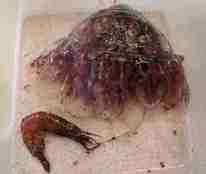Helmet jellyfish is a rare guest in the north

Tommy Aasen and Tom Moldskred are handling the trawl
Photo: Erlend A. Lorentzen / HavforskningsinstituttetPublished: 25.09.2018 Updated: 27.09.2018
By Elena Eriksen, cruise leader on board the research vessel "G.O. Sars" in the Barents Sea
The Barents Sea, a large, high-latitude shelf sea, has been monitored and investigated for more than a century. A joint Norwegian-Russian ecosystem survey is the most comprehensive survey in terms of spatial coverage, number of ecosystem components covered, and resources used in the world. The survey aims to monitor state and changes of the Barents Sea ecosystem. Data collected during the survey is essential for commercial fish stock assessments and reporting the status of climate and other living marine resources.
Periphylla periphylla
RV “G.O. Sars” has newly shifted scientific personnel at Longyearbyen (Svalbard) and continues the survey in the central and western Barents Sea. We were surprised to capture helmet jellyfish southeast of Svalbard on deeper continental slope. Scientific staff gathered around the helmet jellyfish, and started to investigate it.
Monica Martinussen from IMR’s plankton research group took the opportunity to teach us about the jellyfish. Monica has assisted Ulf Båmstedt, earlier colleagues from University of Bergen, with studying jellyfish in the Norwegian waters and the Barents Sea. Their earlier work gave us vital knowledge of jellyfish biology and ecology, and numerous jellyfish papers referred to their work. However, our current knowledge of these subject is fragmented.
The helmet jellyfish (Periphylla periphylla) is a luminescent, red-coloured, deep-water jellyfish which leaves the depth and swim through the water layers to prey on plankton organisms such as copepods, krill, chaetognaths, and ostracods, and swim back when day light come. Day light is deadly for the younger helmet jellyfish and damaging for adults. Jellyfish produces porfyrin, which give red-colour for the tissue and protect them from light.

Helmet jellyfish continuously spawn
Monica told us that helmet jellyfish is an exception in the phylum Cnadaria, presenting a "holopelagic" life cycle where the medusae do not go through a polyp stage. She told that the life-cycle of helmet jellyfish does not depend on season, so at any one time, an individual may be at a different stage. Reproduction occurs year-round. The medusae release fertilized eggs in open water and these develop directly into medusae. We investigated the captured helmet jellyfish and found eggs of different diameter inside the body.
We continued to investigate the jellyfish and observed a big, hard clump inside the helmet. One more surprise was waiting for us when we took out the clump, which belonged to the Norwegian deep-sea shrimp (see photo). We didn’t have such shrimps in the trawl catch and, therefore, helmet jellyfish consumed the shrimp before we captured the helmet jellyfish. This was confirmed by partly digested shrimp in the jellyfish.
Today’s discovery of the helmet jellyfish was very interesting for us. However, we were left with even more questions: What is the distribution and numbers of small and adults helmet jellyfish? Are they competitors with fish juveniles for food? How do they influence the rest of the ecosystem? Which ecological role do they have in the ecosystem?
It is clear that we still have a lot to learn about jellyfish. This knowledge is vital since we are observing more and more jellyfish in Norwegian waters. However, there is still very little focus on jellyfish ecology and interactions with other ecosystem components.
See photos from "G.O. Sars": Slik sjekkar forskarane stoda for alt liv i Barentshavet